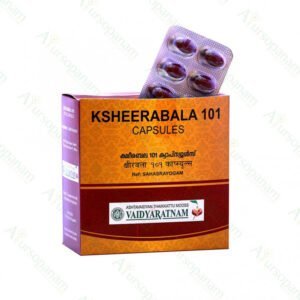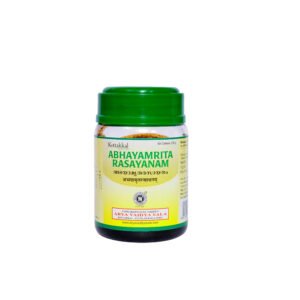Paranthi is the Sanskrit name of Flame of the woods or Ixora coccinea. The plant with its bright red flowers is the signature ingredient of this traditional recipe in a coconut oil base. Paranthyadi Kera Thailam has potent ‘Vishahara’ property or the capacity to neutralize both external and internal toxins. It is indicated for application on the entire body and scalp.
Features & Benefits
- Paranthyadi Kera Thailam is a combination of Paranthi (Ixora coccinea), Vairimula (Salacia reticulata), Nyagrodha (Ficus benghalensis), Aswatha (Ficus religiosa), Udumbara (Ficus racemosa), Plaksha (Ficus microcarpa), Jambeera (Citrus limon), Pichaka (Jasminum grandiflorum), Durva (Cyanadon dactylon), Brahmi (Baccopa monneiri), Parpataka (Oldenlandia corymbosa), Kimsuka (Butea monosperma), Apamarga (Acyranthes aspera) and Haridra (Curcuma longa)in a nourishing base of coconut oil.
- External application is beneficial in immediately cooling and soothing the affected area in case of insect bites and stings, allergies and skin allergies.
- Paranthyadi Kera Thailam reinforces the skin’s natural immunity. Keeps away infection and disease.
- Enriched with the astringent goodness of the ‘Nalpamara’ or the four lactiferous trees of the Ficus species, Paranthyadi Kera Thailam is widely acclaimed for its anti-microbial and skin healing properties, it is an ideal skin tonic that improves tone and complexion.
- Paranthyadi Kera Thailam is also beneficial in the management of chronic skin conditions. Hydrates and nourishes the skin. Locks in moisture.
Dosage and Instructions
Quantity sufficient based on area of application. Apply Paranthyadi Kera Thailam to the scalp and hair length. Massage gently and leave the oil in for atleast 20-30 minutes.
Key Ingredients
Paranthi (Ixora Coccinea)
It is used to treat flatulence, diarrhea, skin diseases, colic, ulcers, wounds, and indigestion, as an antiseptic.
Vata (Ficus Bengalensis)
It is extremely beneficial for treating moles, healing wounds and preventing various skin infections. The Banyan Tree is considered sacred in many parts of India. Food is often served on Banyan tree leaves. Various parts of the plant are considered medicinal. The milky juice is externally applied for bruises and as a pain reliever in rheumatism and back pain. It is also used as a remedy for toothache. The leaves are heated and applied as a poultice to abscesses. The bark is astringent, while the seeds have a cooling effect. The Ayurvedic Pharmacopoeia of India recommends using the aerial root in lipid disorders.
Jati (Grasminum Grandiflorum)
It’s commonly called Royal Jasmine. It has been used for liver disease (hepatitis), liver pain due to cirrhosis, and abdominal pain due to severe diarrhea (dysentery). It is also used to cause relaxation (as a sedative), to heighten sexual desire (as an aphrodisiac), and in cancer treatment. The fresh, tender leaf of the plant is chewed to relieve pain due to dental caries, mouth ulcers and, weak gums. The decoction of the leaf is used for gargling in cases of gingivitis and mouth ulcers.
Durva (Cyonodon dactylon)
Durva also called as Cyonodon dactylon. It is considered complexion enhancing, astringent, moisturizing, demulcent and cooling for the skin. Durva is also considered very good for the eyes and is therefore regarded as a good ophthalmic drug. According to Indian Medicinal Plants—An Illustrated Dictionary by C.P. Khare, Dhub Grass is used as a remedy for inflamed tumors, cuts, wounds, bleeding piles, cystitis, nephritis, scabies and other skin diseases. It has astringent, diuretic, antidiarrheal, anticatarrhal, styptic and antiseptic properties.
Apamarga (Achyranthes Aspera)
A well-known herb is found as a weed throughout India. in different Ayurvedic treatises, it is indicated in Arsha, Kushtha, Unmada, Apasmara, Ashmari, Hikka-Swaas, Vish Chikitsa, etc. Traditionally each and every part of the plant is used in different diseases like dysentery, asthma, piles, stomatitis, etc. It is also used as an anti-diabetic, anti-inflammatory, abortifacient etc.
Haridra (Curcuma longa)
Haridra also called known as Curcuma longa. The anti-inflammatory and antioxidant properties of Haridra assist in preventing the progression of diabetes-related changes in organs like the kidneys, retina, nerve cells and minute blood vessels in the body. Turmeric is a vital herb in Ayurvedic medicine, whose spice form can be recognized by its dazzling, yellow color. The root of the herb, used either fresh or dried, has a host of medicinal benefits. It acts as a carminative and also enhances the complexion and skin tone. in addition, Turmeric can be used to combat liver damage, respiratory disorders, and ulcers.
Ashwagandha (Withanya somnifera)
Ashwagandha is commonly used for stress. It is also used as an “adaptogen” for many other conditions, but there is no good scientific evidence to support these other uses. Ashwagandha contains chemicals that might help calm the brain, reduce swelling (inflammation), lower blood pressure, and alter the immune system. The root contains steroidal compounds which include the lactones Withaferin A and carbon-27-glycowithanolide, known collectively as the Withanolides. The Withanolides are responsible for the varied medicinal applications of the herb. Winter Cherry also contains a fair amount of alkaloids including tropine, pseudotropine, isopelletrine, anaferine and saponins, which impart medicinal properties to the herb.
Chandana (Sanctalum album)
The addition of sandalwood or Chandana nourishes the skin by reducing pimples, acne marks, blemishes, suntan, dullness and excess oil from the skin. This potent herb pacifies Pitta doshas, cleanses the skin, reduces inflammation and effectively treats conditions like diarrhea and piles.
















































Ratings & Customer Reviews
Reviews
There are no reviews yet.